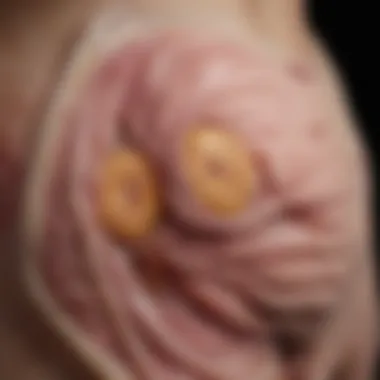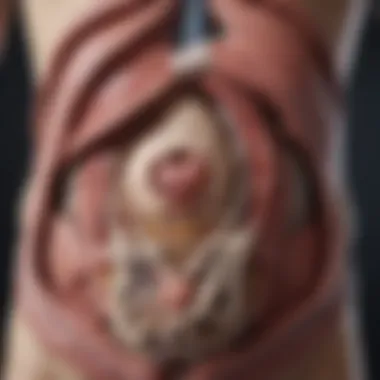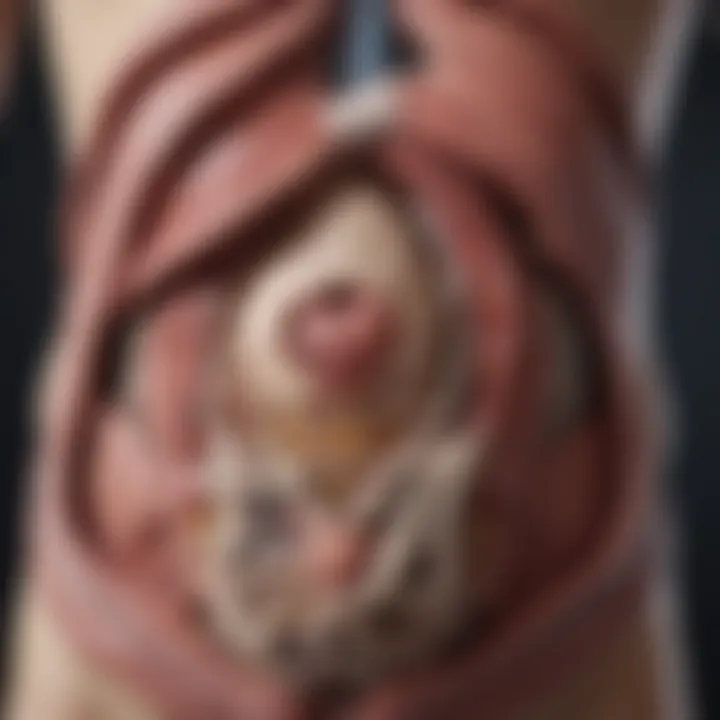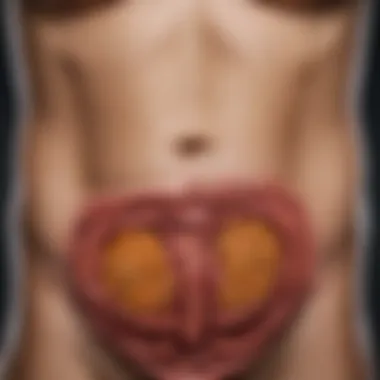Exploring Stomach Sarcoma: Insights and Challenges


Intro
Sarcoma of the stomach, although a rare form of cancer, demands serious attention in the realm of medical research and treatment. Unlike more prevalent gastric cancers, which arise from epithelial tissues, sarcomas originate from the connective tissues, such as muscle or fat. This fundamental difference in origin illustrates why sarcoma is often overlooked in the broader conversation of gastric malignancies.
Understanding the nuances of stomach sarcoma is pivotal for both practitioners and patients. The complexity of this condition can lead to diagnostic delays, resulting in treatment complications. It’s important to highlight that the symptoms can mimic those of more common gastrointestinal disorders, often leading to misdiagnosis.
The objective here is to shed light on critical aspects of sarcoma of the stomach, touching on its epidemiology, pathophysiology, and clinical manifestations. Along the way, we will also prioritize current methodologies for diagnosis and treatment options, aiming to provide a comprehensive view that emphasizes the latest advancements in the field of gastric oncology.
Intro to Sarcoma of the Stomach
Sarcoma of the stomach stands as a rather peculiar entity within the realm of gastric malignancies. Far less common than its better-known cousins, such as adenocarcinoma, these tumors emerge from the soft tissues of the stomach, including fat, blood vessels, and connective tissues. This makes understanding sarcoma particularly essential for healthcare professionals, researchers, and educators who aim to enhance their grasp of this complex disease. The rarity of sarcomas in the gastric region demands a focused discussion that emphasizes their distinct characteristics and implications.
Definition of Sarcoma
Sarcomas are tumors that arise from mesenchymal tissue, which encompasses connective tissues, blood vessels, and lymphatic tissues. It is important to recognize that, unlike carcinomas which originate from epithelial cells, sarcomas have a different cellular origin. To put it simply, these tumors might not just show up in your stomach during a routine check-up, they arise from the muscle or connective tissues lining it, making them a bit of a wild card in the deck of cancer types. Sarcomas can be further classified into various subtypes, including gastrointestinal stromal tumors (GISTs), leiomyosarcomas, and liposarcomas, each with unique histopathological features and clinical behaviors.
Comparison with Other Gastric Neoplasms
When we take a step back to compare sarcomas with more prevalent forms of gastric neoplasms, the differences are quite stark. Adenocarcinomas, the most common gastric cancers, are often associated with risk factors such as Helicobacter pylori infection, smoking, and dietary influences. In contrast, sarcomas are less understood and frequently overlooked in the diagnostic process, given their low incidence.
"Identifying stomach sarcomas can be like finding a needle in a haystack due to their rare occurrence and nonspecific symptoms."
In addition, while adenocarcinomas primarily originate from the epithelial cells lining the stomach, sarcomas spring from the softer tissues, which can lead to more varied signs and symptoms. Notably, the treatment pathways for sarcomas differ significantly; surgical intervention is often crucial, while traditional chemotherapy that works well for carcinomas may not be as effective with sarcomas.
Sarcoma’s unique characteristics mean they often behave in an unpredictable manner, presenting specific challenges for diagnosis and management. This underlines the importance of increasing awareness and understanding of stomach sarcoma among medical professionals and highlights the need for ongoing research and education in this field.
Epidemiology of Sarcoma
Gaining a clear understanding of the epidemiology of stomach sarcomas is crucial in our exploration of this form of cancer. Epidemiology not only sheds light on how common this condition is, but also helps identify risk factors and trends that can guide research and treatment. By examining the incidence and prevalence of sarcoma in the stomach, alongside demographic influences, we can paint a fuller picture of its impact on public health.
Incidence and Prevalence
The statistics surrounding stomach sarcomas reveal a striking picture. Stomach sarcoma, while significantly rarer than adenocarcinoma, accounts for about 1% of all gastric cancers. In terms of incidence, data from various cancer registries suggest that the rates vary widely by geography, with certain regions showing higher occurrences than others. For instance, studies indicate a higher prevalence in specific areas of Eastern Europe and Asia, prompting researchers to ponder if environmental factors play a role in these discrepancies.
In recent years, health organizations have noticed a slight uptick in reported cases, which could be attributed to improved diagnostic techniques rather than an actual increase in incidence.
Overall, while the numbers are relatively low, they still underscore the importance of tailored screening strategies in populations that are at higher risk. Understanding the nuances of incidence and prevalence guides the healthcare system in resource allocation and intervention strategies to combat this rare cancer.
Demographic Factors
When diving deeper into the demographic aspects, it becomes apparent that certain groups are disproportionately affected by stomach sarcomas. Age, gender, and even geographic factors all contribute to the observed patterns.
- Age: Generally, stomach sarcoma tends to manifest more frequently in individuals aged 50 and above. The reasons for this age distribution could be tied to the accumulated risk factors over the years, reinforcing the idea that older adults should be particularly vigilant for any unusual gastrointestinal symptoms.
- Gender: There’s a notable male predominance in sarcoma cases. Research suggests that hormonal differences could potentially influence the development of these tumors, but further studies are needed to establish a definitive connection.
- Geography: As mentioned earlier, the geographic variances invite a closer look. Regional dietary habits, genetics, and exposure to specific carcinogens can illuminate why some populations see a higher prevalence. For instance, individuals in areas with high levels of processed meats in their diet may have increased exposure to potential carcinogenic compounds.
Understanding the demographic trends in stomach sarcoma helps medical providers devise targeted strategies for prevention and early detection.
Pathophysiology
Understanding the pathophysiology of stomach sarcomas is crucial for comprehending how these tumors develop, progress, and respond to treatment. The term encompasses the biological mechanisms that underlie the disease. Delving into this area provides insights into potential therapeutic targets and opens the door for the development of personalized medicine strategies. Moreover, grasping the intricacies of pathophysiology aids in identifying distinguishing features of stomach sarcomas compared to other gastric cancers, which can be essential in guiding diagnostic and treatment decisions.
Cellular Origin of Stomach Sarcomas
Stomach sarcomas are classified under soft tissue neoplasms because of their origin from mesenchymal cells. These cells, which are the building blocks for connective tissues, can give rise to different tumor types, such as gastrointestinal stromal tumors (GISTs), leiomyosarcomas, and angiosarcomas. Each of these variations has a unique cellular lineage and characteristics that influence their behavior clinically.
For instance, GISTs stem from interstitial cells of Cajal or precursor cells. Knowing this can help in tailoring the treatment. Similarly, leiomyosarcomas originate from smooth muscle cells, and their understanding is pivotal for predicting treatment responses and prognostic outcomes.
Key Points about Cellular Origins:
- GISTs often have mutations in the KIT gene, which can be targeted by specific therapies.
- Leiomyosarcomas can be more aggressive and may not respond well to conventional chemotherapy.
- Angiosarcomas, although rare, can emerge from blood vessels and are linked to poorer prognosis due to their aggressive nature.
Molecular Pathways Involved
Molecular pathways play a significant role in the development and progression of stomach sarcomas. Various signaling cascades are involved that help dictate the growth and survival of these neoplasms. One such critical pathway is the PI3K/AKT/mTOR pathway, which is often activated in several types of sarcomas, including GISTs. This pathway promotes cell proliferation and survival, making it a focal point for targeted therapy.
Additionally, the Ras/Raf/MEK/ERK signaling pathway is also implicated. Abnormalities in these signaling routes can lead to uncontrolled cell division and resistance to apoptosis. These insights can shine a light on innovative approaches in treatment, incorporating both classic chemotherapy and newer targeted agents.
Important Molecular Mechanisms:
- Mutations in the CDKN2A gene can contribute to tumor aggressiveness.
- Factors like tumor microenvironment and angiogenesis further complicate the picture, impacting treatment outcomes.
Understanding the molecular pathways offers not just academic interest but also a roadmap for practical clinical strategies in treating sarcomas effectively.
By focusing on the cellular origins and molecular pathways involved in stomach sarcomas, researchers and clinicians can better predict disease behavior and tailor therapeutic approaches. This knowledge underpins a considerable amount of current clinical trials and emerging therapies, making the exploration of these mechanisms highly relevant in the ongoing fight against stomach sarcoma.
Clinical Presentation
Understanding the clinical presentation of stomach sarcoma is critical for early detection and intervention. The symptoms may often be vague or attributed to more common gastrointestinal conditions, thus making it essential for healthcare professionals to stay attuned to potential indicators of this rare malignancy. Recognizing these symptoms can significantly impact the timely diagnosis and treatment planning, which is crucial for improving patient outcomes.
Common Symptoms and Signs
Stomach sarcoma manifests through a variety of symptoms, which can be quite insidious. Some of the more prevalent signs include:
- Abdominal pain: Often described as a dull ache. It might come and go, sometimes confusing patients into thinking it’s something minor.
- Unexplained weight loss: This can be a significant red flag, especially when it occurs without dietary changes or increased physical activity.
- Nausea and vomiting: Many patients report feelings of nausea that may accompany vomiting, making it hard to pinpoint the issue; this may be mistaken for gastric flu.
- Loss of appetite: Sudden disinterest in food can be distressing and may lead to nutritional deficiencies over time.
- Bloating or abdominal fullness: This sensation often leads individuals to feel uncomfortable after eating even small amounts.


These symptoms are not exclusive to sarcoma, which complicates the clinical picture. They can overlap with conditions like gastric ulcers or infections, making awareness and persistence vital in seeking further evaluation if these symptoms persist.
Differential Diagnosis
The process of diagnosing stomach sarcoma often involves ruling out other more common gastric disorders. Some conditions that are considered in differential diagnosis include:
- Gastric Adenocarcinoma: The most prevalent form of gastric cancer. Sarcoma must be distinguished from this due to differing treatment approaches.
- Gastric Lymphoma: This cancer originates in the lymphatic tissue residing in the stomach, and its symptoms can be very similar to those of sarcoma.
- Gastritis and Ulcers: Both conditions cause abdominal discomfort and may present similarly during initial examinations, thus requiring thorough evaluation.
- Functional Dyspepsia: A common disorder causing similar gastrointestinal symptoms, which might distract from underlying issues like sarcoma.
Given the overlap of symptoms, physicians often rely on imaging studies and biopsies to reach a definitive diagnosis. As healthcare practitioners assess an individual displaying these symptoms, remembering to consider sarcoma as a potential diagnosis can be vital for timely treatment.
"Sarcomas are rare, so often their symptoms may be overlooked; yet they require precise attention."
Diagnostic Approaches
Understanding the diagnostic approaches to sarcoma of the stomach is crucial for accurate identification and subsequent treatment. Given the rarity of this type of cancer, its presentation can be subtle and can mimic other gastric disorders. Hence, employing a multifaceted diagnostic strategy ensures that clinicians can differentiate between sarcoma and more prevalent gastric malignancies.
Diagnostic modalities not only aid in confirming the diagnosis but also help in staging the disease, which is pivotal for determining the most appropriate therapeutic interventions. An optimal approach includes imaging and invasive techniques, which together enhance the level of diagnostic precision.
Imaging Studies
Imaging studies play a fundamental role in the initial evaluation of a patient suspected to have stomach sarcoma. Computed Tomography (CT) scans are typically the first line of imaging, providing comprehensive cross-sectional views of the abdominal cavity. These scans can identify tumors and assess their size and extent, offering invaluable information that supports diagnosis. Magnetic Resonance Imaging (MRI) may also be utilized, especially when there is a need for detailed soft tissue contrast.
The benefits of imaging studies include:
- Non-invasive evaluation: Allows for a thorough look at the stomach and surrounding structures without the need for procedures that could cause discomfort or harm.
- Early detection: Can catch unique features of sarcoma that may otherwise be overlooked in standard diagnostics.
- Staging assessment: Helps in understanding the disease's local and distant spread, which is vital in formulating a treatment plan.
However, it's essential to consider that while imaging can reveal the presence of a mass, it may not always provide conclusive evidence of sarcoma. In such instances, further investigation is necessary to avoid misdiagnosis.
Tissue Biopsy Techniques
Tissue biopsy techniques serve as the definitive method for diagnosing stomach sarcoma. These techniques allow for obtaining samples of the tumor, which can then be examined microscopically. The choice of biopsy method often depends on the tumor's location and accessibility. The two primary techniques include endoscopic biopsy and percutaneous needle biopsy.
- Endoscopic biopsy: This method allows direct visualization of the tumor while facilitating the removal of a tissue sample through an endoscope. It's an effective approach when the tumor is located within reach of the gastrointestinal tract.
- Percutaneous needle biopsy: When a tumor is less accessible via an endoscope, radiologic guidance can be utilized to perform a needle biopsy. This procedure, often using ultrasound or CT for accuracy, allows for obtaining a sample from deep-seated tumors in the stomach.
The importance of tissue biopsy techniques includes:
- Confirmatory diagnosis: Pathologic evaluation of the sample confirms the presence of sarcoma, which is necessary for tailored treatment recommendations.
- Histological subtyping: Different types of sarcomas require different treatment approaches, and biopsy results can aid in identifying the specific type involved.
"Timely diagnosis through advanced imaging and precise biopsy techniques can significantly impact treatment outcomes and survival rates for patients with stomach sarcoma."
In summary, the combination of imaging studies and effective tissue biopsy techniques forms the backbone of the diagnostic process in assessing stomach sarcoma. This thorough evaluation enables healthcare professionals to create a detailed picture of the disease, which is instrumental in developing an effective management plan.
Staging of Stomach Sarcoma
Staging plays a pivotal role in understanding sarcoma of the stomach. It is more than just categorizing cancer; it's about guiding both the clinicians and patients through the complex landscape of treatment options and expected outcomes. Knowing how advanced the disease is can shape treatment pathways and offer insights into prognosis, thus providing a framework for effective decision-making and management strategies.
In the context of stomach sarcoma, accurate staging is essential. Sarcomas are often aggressive and may not present symptoms until they are at an advanced stage, making the initial assessment crucial. Here, we delve into the current staging systems in place and what these mean for patients and healthcare providers.
Current Staging Systems
The current staging systems for stomach sarcoma typically include TNM classification, which assesses:
- T (Tumor): Size and extent of the primary tumor.
- N (Nodes): Absence or presence of regional lymph node involvement.
- M (Metastasis): Whether the cancer has spread to other parts of the body.
For sarcomas specifically, the American Joint Committee on Cancer (AJCC) has adapted the system to account for the unique behavior of these tumors. They categorize tumors based on their histology, which can have a significant impact on prognosis.
For example, larger tumors or those that are high-grade may indicate a worse outcome and may necessitate a more aggressive treatment strategy. The AJCC's 8th edition emphasizes adjustments tailored for sarcomas, noting variations in metastatic behavior compared to carcinomas. Having an up-to-date understanding of these classifications is critical for oncologists and their patients.
Implications of Staging for Treatment
The implications of staging are vast. Once the cancer is staged, treatment plans can be precisely tailored. Here are some key considerations involved with the staging process:
- Surgical Decisions: In cases where surgical removal is possible, the stage influences the approach—whether it's a wide resection or potentially more extensive surgery.
- Chemotherapy and Radiation: Neoadjuvant (pre-surgery) therapies may be recommended for higher-stage sarcomas. Similarly, adjuvant therapies post-surgery can minimize the risk of recurrence based on stage.
- Clinical Trials: Staging can also determine eligibility for clinical trials. Many experimental treatments target specific stages of disease, thus widening or narrowing the treatment options available for patients.
"Effective staging not only enhances treatment efficacy but also significantly improves patient satisfaction and outcomes as individuals navigate their unique journeys with stomach sarcoma."
In sum, effective staging serves as a cornerstone for managing stomach sarcoma. It not only steers the clinical course but also empowers patients with knowledge about their condition, enabling informed choices. Understanding where one stands in the staging system articulates a clear path towards management and potential recovery.
Treatment Options
When talking about sarcoma of the stomach, understanding the treatment options is a pivotal part of the discussion. This aspect not only highlights how healthcare professionals approach therapy for this aggressive form of cancer but also sheds light on the multidisciplinary efforts that go into patient care. Unlike more prevalent gastric cancers that might follow a standardized treatment plan, sarcomas require a tailored approach due to their unique biological characteristics.
Below are critical components surrounding the treatment options for stomach sarcoma, emphasizing their benefits and the considerations that must be taken into account.
Surgical Interventions
Surgery often stands as the cornerstone for treating sarcoma of the stomach. Surgical interventions aim to completely remove the tumor and any surrounding affected tissue. Review of current practices suggests that the more aggressive the surgical approach, the higher the chance patients have for long-term survival. Some of the surgical options include:
- Resection: This involves removing the tumor along with a margin of healthy tissue. It's the primary strategy when the sarcoma is localized.
- Gastric Bypass: In advanced cases, this technique might be utilized not only as a treatment but also as a way to manage complications like gastrointestinal obstruction.
- Palliative Surgery: This might come into play for improving quality of life if the disease is not operable; for instance, relieving symptoms like blockage.
"A successful surgical approach can significantly improve outcomes and prolong survival, but it must come with proper planning and consideration of the patient’s overall health."
The decision to proceed with surgery is influenced by factors like tumor size, location, and the overall health of the patient. Notably, the postoperative phase includes monitoring for recurrence, which is pivotal since sarcomas can be notorious for returning.
Chemotherapy Regimens


Chemotherapy is commonly viewed as a secondary treatment after surgery, aimed at eliminating any remaining cancer cells. However, it is also applied pre-operatively (neoadjuvant therapy) to shrink tumors before a surgical intervention. Some of the commonly used chemotherapeutic agents include doxorubicin and ifosfamide. Key advantages of chemotherapy include:
- Tumor Reduction: Shrinking the tumors enables surgeons to perform more effective resections.
- Addressing Metastasis: In cases where the cancer has spread, chemotherapy helps in managing and reducing tumor load throughout the body.
Nonetheless, the side effects can be daunting; patients might experience nausea, fatigue, and a weakened immune system. Choices in chemotherapy regimens must thus consider the balance between efficacy and quality of life, often necessitating a league of specialists to monitor and manage potential adverse effects.
Radiation Therapy Considerations
Radiation therapy plays a more specialized role in treating stomach sarcoma. Generally, it is not the primary modality but can serve as an adjunct to surgery, either pre-operatively or post-operatively. Radiation is particularly beneficial for patients with incomplete resections or those who are considered inoperable. Advantages of radiation therapy include:
- Local Control: It helps to control local disease, ensuring that any residual cancer cells are targeted.
- Pain Relief: Particularly in cases where sarcoma is causing pain due to pressure on nearby structures, radiation can alleviate discomfort.
However, the application of radiation therapy is deliberate and must be handled with caution. risks involved include damage to healthy tissue and potential complications, thus requiring collaborative care teams to design a treatment course tailored specifically to the patient.
In sum, treatment options for sarcoma of the stomach encompass an intricate interplay of surgical, chemotherapeutic, and radiotherapeutic strategies tailored to the individual patient. Regular interdisciplinary communication is key to navigating these options, ensuring that patients receive comprehensive and effective care.
Adjuvant and Neoadjuvant Therapies
Adjuvant and neoadjuvant therapies play a crucial role in the management of stomach sarcoma. These treatment strategies are designed to improve patient outcomes by complementing the main treatment approaches, particularly surgery. The significance of these therapies cannot be overstated, as they can potentially increase survival rates and reduce the risk of recurrence.
Overview of Approaches
Adjuvant therapy refers to treatments that are administered after the primary surgical intervention, while neoadjuvant therapy is given before surgery. Each has its distinct rationale and set of advantages:
- Neoadjuvant Therapy: This approach is primarily aimed at shrinking the tumor prior to surgical removal. By reducing the tumor's size, it may make surgical resection simpler and potentially enhance outcomes. Additionally, early treatment can help to tackle micro-metastatic disease that isn't detectable yet.
- Adjuvant Therapy: Once the tumor is removed, adjuvant treatments aim to eliminate any remaining cancer cells. This helps in reducing the risk of recurrence and can be crucial in high-risk patient populations. Common modalities include chemotherapy, targeted therapy, and, in some cases, radiation.
Both approaches are underpinned by the idea that comprehensive treatment can tackle the subtle complexities of sarcoma biology. They hold promise especially in rare cases where traditional therapies may not yield significant results.
Clinical Trial Insights
Recent clinical trials have begun to shed light on the effectiveness of adjuvant and neoadjuvant treatments in stomach sarcoma. Some noteworthy insights include:
- Increased Efficacy: Trials have shown that patients receiving neoadjuvant therapy may exhibit a better response, making initial surgery more effective.
- Combination Therapies: Studies are exploring combinations of chemotherapy and targeted therapies, revealing a trend towards improved survival rates.
- Biomarker Utilization: Research has also highlighted the role of biomarkers in predicting responses to therapies, enabling more personalized treatment plans.
"The integration of adjuvant and neoadjuvant therapies represents a shift towards a more proactive and tailored approach to stomach sarcoma treatment, assessing the unique needs of each patient."
Prognosis and Survival Rates
Understanding the prognosis and survival rates for stomach sarcoma is essential for several reasons. First, it gives patients and their families a more realistic picture of what to expect in their journey. Secondly, it can guide healthcare professionals in making informed decisions about treatment plans. Lastly, this information can shape future research directions, particularly in understanding the disease further and improving therapeutic methods. Prognosis may vary significantly based on numerous factors, and this section will explore them in detail.
Factors Influencing Prognosis
A multitude of variables come into play when assessing the prognosis for someone diagnosed with stomach sarcoma. Some of the more significant factors are:
- Tumor Size and Type: Larger tumors generally lead to a poorer prognosis. Moreover, the specific type of sarcoma—be it leiomyosarcoma or other variants—can influence survival odds.
- Metastasis: If the cancer has spread to other parts of the body, the prognosis drops considerably. Metastatic disease is often associated with lower survival rates.
- Histological Grade: The grade of the tumor describes how much the cancer cells differ from normal cells; higher grades typically suggest a more aggressive tumor, affecting expected outcomes.
- Patient’s Overall Health: A person's age, underlying health conditions, and overall fitness can affect their ability to endure specific treatments and the disease itself.
It's integral to recognize that while these factors can suggest trends in survival rates, individual cases may vary widely. Speaking with healthcare providers for personalized assessments remains crucial.
Statistical Outcomes
Survival statistics for stomach sarcoma can be grim, but they do provide necessary insight into the expected trajectory of the disease. A few key points to consider:
- Five-Year Survival Rate: The five-year survival rate for stomach sarcoma varies broadly; some studies suggest it can be as low as 10-20% in advanced cases, while localized conditions may allow for rates above 50%.
- Variability Across Types: Different sarcoma types have distinct survival expectations. For example, exceedingly rare forms may have different benchmarks than more prevalent variants.
- Data from Clinical Trials: Participation in clinical trials may influence outcomes. Emerging therapies can lead to better survival rates as they progress through research phases, potentially offering new hope for patients.
"Survival rates are statistical figures, not personal predictions. Each individual’s case is unique, and survival outcomes should be discussed directly with a healthcare provider."
The insights into these statistics serve as a double-edged sword. While they can assist in understanding general trends, they should not deter anyone from actively pursuing treatment options or hope. Awareness and research continue to advance, offering a brighter outlook for future patients.
Living with Stomach Sarcoma
Living with stomach sarcoma presents a mountain of challenges, often making the daily lives of patients and their families complex and emotionally taxing. Recognizing this reality is invaluable, not just for the patients but for caregivers, medical professionals, and support networks. It’s imperative to understand that managing a rare cancer like this requires not just medical intervention, but a holistic approach that incorporates emotional and practical support.
Dealing with a diagnosis of stomach sarcoma can feel as if the ground has been pulled from under one’s feet. It throws one into a whirlwind of treatment decisions, coping strategies, and lifestyle adjustments. Managing symptoms and side effects from treatments—like nausea, fatigue, or pain—becomes crucial, alongside a strong support system. This section will delve deeper into two major aspects of living with this condition: supportive care strategies and nutritional considerations.
Supportive Care Strategies
Supportive care, often referred to as palliative care, adapts to the individual’s needs, focusing on improving quality of life. Far from the misconception that it is only for end-of-life scenarios, supportive care plays a significant role throughout all stages of treatment and recovery.
Some effective strategies could include:
- Pain Management: It may involve medications, physical therapy, or even acupuncture. Finding the right balance can dramatically improve comfort.
- Mental Health Support: Regular consultations with a psychologist or counselor can help tackle anxiety or depression, which often accompany a cancer diagnosis.
- Peer Support Groups: Connecting with others facing similar challenges can provide emotional backing and practical advice. It’s a resilient feeling to share experiences.
- Holistic Therapies: Practices such as yoga, meditation, or art therapy might help in alleviating stress and promoting a sense of well-being.
"Coping isn't about making it go away but embracing the uncertainty and creating a life that functions alongside it."
Nutritional Considerations
Dietary choices can make a significant difference for individuals living with stomach sarcoma. The battle for energy and nourishment becomes a crucial part of their daily regimen. The right nutrition can help bolster the immune system, support recovery, and maintain strength during treatments.
Here are some basic guidelines to consider:
- Balanced Diet: Incorporating a variety of fruits, vegetables, lean proteins, and whole grains ensures the body has all essential nutrients.
- Hydration: Staying well-hydrated is key, especially when experiencing side effects like diarrhea or vomiting due to treatments.
- Small, Frequent Meals: Eating smaller portions more frequently throughout the day can help maintain energy levels without overwhelming the stomach.
- Monitor Food Tolerance: Individuals might find that some foods aggravate symptoms. Keeping a food diary can help in spotting and avoiding these triggers.
Research Developments
Research developments in the realm of sarcoma of the stomach are crucial as they pave the way for more effective diagnostic methods and innovative treatment protocols. Given the rarity and aggressive nature of stomach sarcomas, the field demands rigorous scientific inquiry and exploration. This section underscores the importance of ongoing research towards achieving earlier diagnoses, understanding tumor biology, and enhancing patient outcomes.


Emerging Therapies
In the evolving landscape of sarcoma treatment, emerging therapies are becoming a beacon of hope. One of the key areas of research is the integration of targeted therapies. These therapies focus on the molecular characteristics of the tumors, aiming to disrupt specific pathways that contribute to tumor growth and survival.
- Targeted Molecular Therapies: In recent studies, medications such as imatinib have shown promise in treating specific subtypes of sarcoma. This approach enables a more tailored treatment, potentially leading to better outcomes as clinicians match therapies to the unique molecular profile of a patient’s tumor.
- Immunotherapy: Another exciting area is the development of immunotherapeutic agents. These therapies harness the body’s immune system to combat cancer cells. Investigating mechanisms like checkpoint inhibitors is crucial, as they have revolutionized treatment for several cancer types, and their applicability to gastric sarcoma is under increasing scrutiny.
- Combination Therapies: Combining different treatment modalities is also gaining traction. For instance, studies are analyzing the synergy between chemotherapy and targeted therapies, aiming to maximize patient benefits while minimizing resistance development. Successful outcomes in clinical tests could open new doors for treatment strategies.
Continued investment in research and clinical trials to evaluate these emerging options is vital. It helps define the role of these therapies in a broader treatment plan, ensuring that patients receive the most effective interventions based on the current scientific knowledge.
Innovation in Clinical Trials
Innovation in clinical trials serves as the backbone of advancements in sarcoma treatment. A focus on novel trial designs can lead to significant breakthroughs. There are a few elements that stand out in the innovation of clinical trials relevant to stomach sarcomas:
- Adaptive Trial Designs: These types of trials allow modifications to the trial procedures in response to preliminary results. This flexibility can enhance patient accrual and reduce the time taken to identify effective treatments.
- Biomarker-Driven Studies: An emerging trend is the incorporation of biomarker analysis in clinical trials. By identifying predictors of response to specific therapies, researchers can stratify patients based on their likelihood of benefiting from particular interventions.
- Engagement of Patient Populations: Involving patient populations in the design and execution of trials can enhance recruitment rates and ensure that research priorities align with patient needs. Increased diversity in trial participants also aids in understanding how different demographics respond to treatments.
- Integration of Real-World Evidence: Incorporating real-world evidence into clinical trial designs also holds promise, reflecting how treatments perform outside the controlled environment of clinical trials. This data can be invaluable in informing treatment protocols and understanding long-term outcomes.
Research developments focusing on emerging therapies and innovative trial approaches symbolize the future of cancer treatment. As the scientific community delves deeper into the complexities of sarcomas, the potential to significantly improve patient care in gastric oncology continues to unfold.
Ethical Considerations in Treatment
The ethical landscape surrounding sarcoma treatment is multifaceted and demands careful navigation. In dealing with a rare and aggressive condition like stomach sarcoma, patients, healthcare providers, and researchers must engage in a dialogue that prioritizes trust, morality, and shared decision-making. This section introspects the crucial elements of ethical considerations in treatment, aiming to shed light on the responsibilities and challenges inherent in providing care for these individuals.
Patient Autonomy and Decision-Making
Patient autonomy stands as a cornerstone of modern medical ethics. In the context of stomach sarcoma, empowering patients to make informed decisions about their treatment options is vital. Yet, when faced with complex medical information and the gravity of a sarcoma diagnosis, many patients may feel overwhelmed. Recognizing this, healthcare teams must foster an environment where patients can voice their concerns, preferences, and values regarding their treatment.
The principle of informed consent is pivotal here. It ensures that patients are not only aware of their condition but also grasp the potential implications of different therapeutic approaches. For instance, a patient may opt for aggressive surgical intervention based on the desire for immediate resolution, while another might prefer a palliative approach to prioritize quality of life. Both decisions are valid, implying that health practitioners must provide relevant information tailored to the patient's understanding.
In recent discussions around patient autonomy, shared decision-making models are gaining traction. These methodologies involve healthcare professionals guiding patients while allowing them to retain decision-making power. This partnership acknowledges patients’ unique perspectives and encourages them to participate actively in their care.
"Empowerment comes from knowing your options and participating in your treatment journey."
Balancing Risks and Benefits
When it comes to stomach sarcoma treatment, balancing the risks and benefits of different interventions can feel like walking a tightrope. On one hand, aggressive treatments like chemotherapy or radical surgery may offer the hope of remission or extending survival; however, they come with their fair share of risks, such as adverse side effects and complications.
The ethical responsibility of healthcare providers involves a thorough evaluation of these risks in light of the potential benefits. Engaging in discussions about the likelihood of success, the nature of side effects, and alternative treatment options is essential. For example:
- Surgical options may promise a clean removal of the tumor but could also result in significant recovery challenges and unsettling emotional outcomes.
- Chemotherapy has a chance of shrinking the tumor, yet is notorious for causing fatigue, nausea, and other debilitating symptoms that can affect a patient's quality of life.
Moreover, as treatment modalities evolve with new research and clinical trials, the ethical questions multiply. On one hand, experimental treatments may provide hope for patients out of conventional options; on the other hand, the uncertainty of outcomes can be unsettling and raises ethical dilemmas about patient vulnerability and exploitation.
Ultimately, the nuances of balancing risks and benefits hinge on clear communication and compassionate care. The goal is not only to provide treatment but also to support patients in making choices that align with their personal goals and values, ultimately fostering an environment of trust and understanding.
Future Directions in Research
Exploring the future of sarcoma research in the stomach is crucial given the complexities that surround this rare form of cancer. While strides have been made in the understanding of gastric sarcomas, key areas still require in-depth investigation to better diagnose, treat, and ultimately improve outcomes for patients.
As we look ahead, there lies a pressing need to refine diagnostic techniques that can lead to early detection. Enhanced imaging technologies and advanced molecular profiling may provide invaluable insights into the disease. Novel biomarkers could aid in identifying those who are at a higher risk, tailoring screening processes to catch the malignancy before it progresses.
Another essential facet involves treatment optimization. Current regimens, while effective for some, may not suffice for others, and there is a growing need for research into personalized medicine. Using genetic profiling of the tumors, researchers can potentially identify specific therapies that cater to the unique molecular characteristics of each patient's sarcoma.
Moreover, the integration of artificial intelligence in predicting comprehensive treatment responses holds promise. The fusion of big data with clinical insights can lead to tailored treatment plans that improve survival rates and quality of life. Overall, the next chapter in sarcoma research may focus heavily on these innovations, which could foster a paradigm shift in how the medical community approaches this aggressive disease.
"In the world of cancer, research is the vital engine that drives the potential for better outcomes."
Areas Needing Exploration
- Biomarkers for Early Detection: There's an urgent need to identify effective biomarkers that can signal the presence of stomach sarcoma before clinical manifestation. This could facilitate timely intervention and improve prognostic outcomes.
- Genetic Factors: Investigating the genetic predispositions to sarcomas may uncover heritable traits that could be screened for in high-risk populations, laying the groundwork for preventative measures.
- Long-Term Impacts of Treatment: Understanding the long-term effects of various treatment modalities is essential for improving patient care. Future studies should focus on the sequelae of cancer therapy to enhance survivorship care.
- Quality of Life Assessments: Research ought to include thorough evaluations of patients' quality of life post-treatment. Measuring psychosocial impacts and support mechanisms can provide holistic insights into patient well-being.
Potential for Interdisciplinary Collaboration
Collaboration across various fields could drastically enhance the research landscape for stomach sarcoma. Harnessing expertise from clinical oncologists, geneticists, radiologists, and even bioinformaticians could lead to more rounded and comprehensive studies.
- Oncologists can provide clinical insights on treatment efficacy.
- Geneticists could identify mutations that contribute to sarcoma progression.
- Radiologists could pioneer advanced imaging techniques to improve diagnosis.
- Bioinformaticians can help analyze complex data from genomic studies.
This interdisciplinary approach may result in breakthrough therapies and interventions, effectively bringing the latest scientific discoveries into clinical practice efficiently. Moreover, fostering relationships between academic institutions and pharmaceutical companies is key to translational research; it ensures that promising laboratory findings swiftly translate into real-world applications.
Culminations and Implications
In the realm of gastric oncology, sarcoma of the stomach remains a challenging and intricate topic that necessitates thorough discourse. This article serves not only as a foundational reference but also as a springboard for future explorations. Understanding sarcomas, particularly their unique presentation and management, is crucial given their rarity and aggressive nature. This section highlights the importance of working towards improved diagnosis, treatment options, and overall patient care for those afflicted.
The implications of studying sarcoma involve several key aspects:
- Raising Awareness: Enhanced awareness among healthcare professionals can lead to earlier detection and more appropriate referral to specialized centers.
- Research Opportunities: Identifying gaps in current knowledge prompts targeted research, which can lead to the development of innovative therapies.
- Patient Education: Educating patients and their families about their condition is vital. Informed patients can engage more effectively with their healthcare teams, driving better health outcomes.
This comprehensive examination sheds light on the complexities surrounding the diagnosis and management of stomach sarcoma. By summarizing the findings, healthcare providers can glean insights that are pivotal for clinical practice.
“Knowledge is power, especially when it comes to rare diseases like sarcoma. The more we understand, the better equipped we are to fight.”
Summarizing Key Insights
Throughout this article, several key insights emerge:
- Definitions and Distinctions: Sarcoma is distinct from more prevalent forms of gastric cancer, making it critical to differentiate between them in clinical settings to avoid misdiagnosis.
- Epidemiological Trends: Understanding who is affected by stomach sarcoma can guide future research and improve prevention strategies.
- Pathophysiology: A thorough comprehension of the cellular and molecular underpinnings of stomach sarcomas highlights potential therapeutic targets.
- Diagnostic Techniques: Advances in imaging and biopsy methods improve the accuracy of diagnoses, playing an essential role in shaping treatment plans.
- Treatment Modalities: Existing options, including surgical interventions, chemotherapy, and emerging therapies, emphasize the need for personalized treatment approaches for better prognostic outcomes.
These insights collectively foster a deeper understanding of the disease, which is essential for both researchers and clinicians.
Final Thoughts on Stomach Sarcoma
In closing, the exploration of stomach sarcoma sets the stage for future inquiry and clinical practice. Given its complexity, ongoing research is paramount. As we refine our understanding of the various biological pathways and therapeutic options, we pave the way for more effective interventions.
The integration of emerging therapies into clinical practice, along with an active commitment to research, holds the promise for improving the prognosis and quality of life for patients diagnosed with this aggressive neoplasm. A future in which stomach sarcomas can be treated with precision is not just a possibility but a necessity as we strive for better outcomes in this often-overlooked aspect of gastric cancer.



